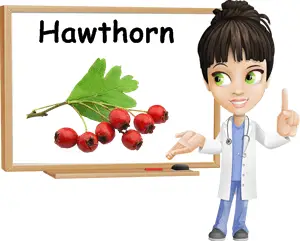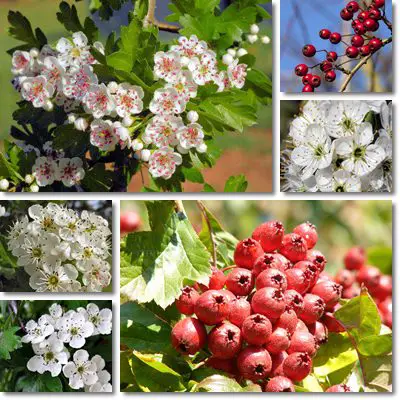The common hawthorn (Crataegus monogyna) is an European shrub of great medicinal value. Since its discovery, hawthorn has been used to successfully treat a variety of medical conditions, notably heart and vascular problems. Extracts from this plant are now being used to improve heart function in people diagnosed with heart failure and can help improve anxiety as well as cardiovascular symptoms such as palpitations, extrasystoles or lower high blood pressure.
Research has shown that hawthorn extracts as well as infusions from hawthorn sprigs, together with leaves, flowers and berries help treat palpitations, fatigue associated with heart failure, shortness of breath, chest pain and hypertension. Moreover, when taken as complementary medication, hawthorn appears to increase the efficacy of several blood pressure-lowering medication.

What is hawthorn?
Hawthorn goes under a lot of names, notably Mayblossom, Whitethorn (due to its white flowers), Maythorn, Mayflower, May bush, May tree, Haw (this is also the name for hawthorn berries), Hagthorn or English Hawthorn. Hawthorn blooms in May-June and was traditionally used to decorate Maypoles, hence its names May bush, Mayblossom and so on. Because it has thorny branches, it is often referred to as Thorn. If left to mature, hawthorns can grow to impressive-tree like sizes and live well beyond 500 years. Several such specimens have been identified in England and testify to the spectacular longevity of the shrub. Hawthorn leaves, flowers and berries are all a great source of powerful antioxidants and exhibit some of the most incredible health benefits.
What does hawthorn look like?
Hawthorn is a shrub with thorny, gray branches, three-lobed dark green leaves and small, white flowers with rounder petals. Some varieties bear beautiful deep-pink flowers. Hawthorn can be found in sunny locations such as open fields, pastures, even parks, riversides or home gardens. Bees collect nectar and pollen from hawthorn flowers and make a specialty monofloral honey variety called hawthorn honey.
What do hawthorn berries look and taste like?
The fruit of the hawthorn shrub is a small, oval or olive-shaped bright red berry with one or more seeds. It is called haw. Hawthorn berries have a subtle flavor and a fleshy texture. Although raw haws are edible, they are usually made into various jam recipes. See the benefits of hawthorn berries.

What are the benefits of hawthorn?
Management of congestive (chronic) heart failure
Extensive research on the effects of hawthorn consumption on cardiovascular health show that extracts from the plant can help manage heart failure, a medical condition characterized by the inability of the heart to pump blood efficiently. In most studies, patients diagnosed with chronic heart failure were given hawthorn extracts in various amounts for periods of time ranging from 4 weeks to 2-4 months. The results showed a significant increase in exercise tolerance, improving debilitating heart failure symptoms such as fatigue, shortness of breath and palpitations.
Hypertension treatment
Hawthorn extracts or regular consumption of infusions made from hawthorn sprigs with leaves, flowers or berries were shown to efficiently lower high blood pressure (hypertension). A 2002, 10 week-long pilot study conducted on 38 volunteer-subjects diagnosed with hypertension is one of the many of its kind promoting hawthorn as a natural remedy for high blood pressure. Half of the subjects were given 600 mg of magnesium and 500 mg of hawthorn extract daily, while the other half received a placebo.
After 10 weeks, the first group showed a significant reduction in diastolic blood pressure, while the condition of the placebo group did not improve. Moreover, the subjects on hawthorn and magnesium reported an improvement in their mood as well as lower anxiety levels. Hypertension is both a symptom and a cause of chronic heart failure. Maintaining normal blood pressure levels can play a major role in the prevention of cardiovascular disease and cardiovascular events such as stroke or heart attack. Read more about the benefits of hawthorn for high blood pressure.
Natural remedy for atherosclerosis prevention
Hawthorn is a rich source of powerful antioxidants which contribute to cardiovascular health by maintaining the integrity of blood vessels and reducing cholesterol levels and, consequently, atherosclerosis risks. Atherosclerosis is the buildup of mostly fat, but also calcium and other deposits on the inside of artery walls, thus restricting blood flow. Over time, the condition worsens, leading to coronary artery disease, angina (or chest pain) and myocardial infarction.
The University of Maryland conducted several studies which concluded that hawthorn not only reduces blood lipid (fat) levels, but also improves heart function in patients diagnosed with heart failure and stops the progression of atherosclerosis.
Digestive benefits
Hawthorn preparations such as hawthorn tea are natural remedies for the treatment of abdominal discomfort. Hawthorn boasts mild antispasmodic properties, meaning it is good for relieving abdominal discomfort such as cramps caused by indigestion.
Anti-anxiety remedy
Though it does not affect brain or nervous system function, hawthorn lowers high blood pressure and helps with palpitations, two potential symptoms of anxiety disorder. By helping manage symptoms, the plant contributes to better anxiety management and represents a natural anti-anxiety remedy.
Hawthorn side effects and contraindications
However, keep in mind that heart failure is a serious medical condition and under no circumstances whatsoever should you stop taking your medication in favor of any herbal remedy prior to consulting with your doctor. Go see your doctor and he/she may very well be in favor of complementary medication to help manage your condition. As a complementary treatment, hawthorn will most likely help improve your health, but it is important to go see your doctor first to check whether or not it interacts with the medication you are taking.
For instance, extracts (which are more powerful than infusions) may enhance the activity of certain medication due to having the same effects as beta-blockers such as digoxin (in Digoxin-Sandoz, Digoxine, Lenoxin, Novodigal, Toloxin, etc) or blood pressure lowering medication such as atenolol, labetalol, metoprolol or propanolol. If your doctor is of the opinion that hawthorn will not interact with the medication you have been prescribed, then you can take it as a complementary medication, to increase your general state of health.
If you are experiencing side effects such as nausea, excessive sweating, alertness or feeling lightheaded, then you might be experiencing a blood pressure drop as a result of taking too much hawthorn or combining hawthorn and heart medication. Other side effects include more chest pain attacks, usually after a meal, during and after mild physical effort, or when lying in bed, palpitations, dizziness or increase in fatigue, even a sedation-like feeling. Side effects are typically dose-dependent.
Conclusion
In addition to having impressive vasodilating properties, hawthorn is also a good antispasmodic which is why it is often used to treat stomach cramps or indigestion. Moreover, poultices are applied to ulcerations or rashes to treat itching. Regular consumption of hawthorn tea not only maintains cardiovascular health and improves heart conditions, but also reduces stress and anxiety, common causes of palpitations.
